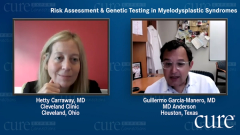
Treatment Goals in Myelodysplastic Syndromes
Episodes in this series

Guillermo Garcia-Manero, MD: Hetty, let me ask you a question if you don’t mind. Now that we’re talking about the incorporation of these agents, how do you measure the response? How long do you wait for the therapy to show any evidence of activity?
Hetty Carraway, MD: For the ESA [erythropoiesis-stimulating agent]-based therapy, we’ll typically keep our patients on ESA therapy for about eight to 12 weeks. I tend to favor closer to 12 weeks to make sure we’re giving people a fair shot at staying on this therapy before we evaluate for a decrease in the number of transfusions that our patients are requiring, or an increase in their hemoglobin by 1.5 g/dL. Those are things that we look at to measure our patients having an improvement in their hemoglobin criteria with these agents, and if they are, we then can continue them on these therapies.
It is important because patients can end up on these therapies for a very long time, not benefiting from them, and then they’re incurring toxicity without having benefit. Equally important with knowing when to start a therapy is when to stop if it’s not helping your patients. That’s one piece of information that patients and caregivers should be aware of. It’s OK to ask, “Should I still be on this therapy? Is it helping me?” And if it is, then of course, we want to keep you on it. But if it isn’t, then we need to move to the next option in terms of therapies.
Guillermo Garcia-Manero, MD: Can you describe the threshold for transfusion of red blood cells and how you do that? Also, what is the impact of these transfusions or therapies in terms of the quality of life? Can you go over the toxicity a little bit? What are the levels of hemoglobin for transfusion? This is something that is very obvious to us, but that’s the first question my patients ask. Talk a little bit about quality of life and toxicities.
Hetty Carraway, MD: We alluded to the goals of therapy for patients with MDS [myelodysplastic syndromes] and as you mentioned, many of our patients are older. If they have comorbidities, some patients can’t consider curative therapy with a bone marrow transplant, and we find ourselves in an area where our goals of care are to improve quality of life and delay progression of disease. In that setting, many of my patients tend to be symptomatic in terms of increased fatigue, increased shortness of breath, and decreased ability to do the activities that bring them joy. With a hemoglobin level less than 8.0 g/dL, people are typically symptomatic with increased shortness of breath with exertion, going to the store, or doing other activities around the house, such as gardening, and spending time with family. For many of our patients, if the hemoglobin level is less than 8.0 g/dL, we offer transfusion of packed red blood cells.
In this time of COVID-19 [coronavirus disease 2019], we’ve had to restrict the amount of transfusions for some patients. Sometimes that threshold has gone down to as low as less than 7.0 rather than less than 8.0 g/dL. Some of my older patients with comorbidities, such as COPD [chronic obstructive pulmonary disease], heart failure, or CHF [congestive heart failure], have needed transfusions sooner—so with a hemoglobin of less than 8.5 g/dL. Having patients who are symptomatic can change that parameter, and many of our patients know when that is. But we try to standardize our practice across our enterprise here at the Cleveland Clinic, and having a hemoglobin level of less than 8.0 g/dL is where we typically land for offering transfusion support.
With regard to platelets, we try not to give patients platelets because of the development of antibodies. We want them to have platelets that are useful if they are, in fact, having bleeding. If they’re symptomatic with bleeding events, then often we will offer platelet transfusion support, and it can be incredibly scary as you talked about. The risk of bleeding for patients with low platelets remains a challenge, but we try not to offer transfusions just to fix a number.
In patients with issues with neutropenia, where patients can be neutropenic but not have frequent infections, we don’t tend to do too much to boost that neutrophil count with G-CSF [granulocyte colony-stimulating factor]. If they’re not having active infections, you have to treat the patient, not the number. I always come back to talking with my patient about how they’re feeling, what’s going on, and if the trajectory of their quality of life has changed in any way to dictate how we’re moving forward.
Guillermo Garcia-Manero, MD: Something that I see in my practice is the patient may not be benefiting any more from the ESA, yet they continue on therapy. Of course, in general, these drugs are not very toxic, although they have financial toxicity that I don’t know if patients or doctors realize. But I will see patients who for many months have been on this therapy when they really fail. Sometimes the doctors are already using some other treatments but they continue with the ESA. Can you tell us a little bit about failure—specifically of these ESAs—and when you would consider a second-line type of compound, such as luspatercept, for these patients?
Hetty Carraway, MD: These agents, ESAs, can fail patients. It’s really the agents that we’re using that can no longer add benefit to patients. If patients have been on these ESA-based therapies for four months and they’re still transfusion dependent, there can be toxicities from ESA-based therapy, including hypertension and even fluid retention. For some of those toxicities, it is important for patients to be aware of them.
I have had a number of patients who have been on ESA-based therapy and they’re not benefiting from them. They’re still transfusion-dependent, just as much as they were before they started the therapy. At that point, it’s important to address that they’ve been on these therapies, at times increasing the dose of that ESA, and they’ve been on that increased dose of ESA-based therapy for some time, and their transfusion dependence has not gone down. In fact, for some patients, it goes up. In those scenarios, it’s very reasonable to stop ESA-based therapy. For some of those patients, you just need to give them a break. Even if we don’t have everything perfectly lined up for the next therapy, stopping the ESA-based therapy is OK because it’s probably only adding toxicity and not adding benefit.
Talking about what the next steps are for therapy are inclusive of the exact things that you talked about, like lenalidomide for patients, or even luspatercept if it’s appropriate. For some patients, not only are they having increased transfusion requirements, but there may be other things going on, such as a decreasing platelet count or a decreasing neutrophil count. If we’ve gone from a single line, like if it’s anemia, to other lines being more affected with cytopenia, such as a lowering platelet count or a lowering neutrophil count, that would be a time where we need to readdress and potentially repeat a bone marrow biopsy to reevaluate what’s going on in the blast population and see if there’s progression of disease. If there is, we may need to change the therapy altogether, moving to a higher-risk paradigm such as a hypomethylating-based therapy and address potential progression of disease.
Transcript Edited for Clarity















